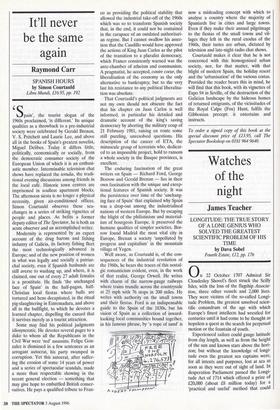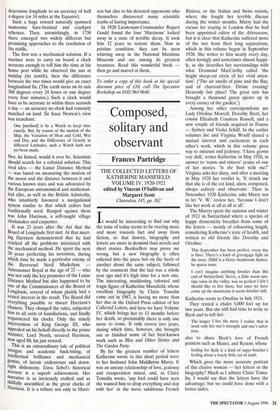Watches of the night
James Teacher LONGITUDE: THE TRUE STORY OF A LONE GENIUS WHO SOLVED THE GREATEST SCIENTIFIC PROBLEM OF HIS TIME by Dava Sobel Fourth Estate, £12, pp. 176 n 22 October 1707 Admiral Sir Cloudesley Shovel's fleet struck the Scilly Isles, with the loss of the flagship Associa- tion, three other vessels and 2,000 lives. They were victims of the so-called Longi- tude Problem, the greatest unsolved scien- tific conundrum of the age with which Europe's finest intellects had wrestled for centuries until it had come to be thought as hopeless a quest as the search for perpetual motion or the fountain of youth.
Experienced sailors could gauge latitude from day length, as well as from the height of the sun and known stars above the hori- zon; but without the knowledge of longi- tude even the greatest sea captains were, for all intents and purposes, lost at sea as soon as they were out of sight of land. In desperation Parliament passed the Longi- tude Act of 1714 which offered a prize of £20,000 (about £8 million today) for a 'practical and useful' method that could determine longitude to an accuracy of half a degree (or 34 miles at the Equator).
Such a huge reward naturally spawned numerous hare-brained and crackpot schemes. Then, astonishingly, in 1730 there emerged two widely different but promising approaches to the resolution of the riddle.
The first was a mechanical solution. If a mariner were to carry on board a clock accurate enough to tell him the time at his home port while he observed the sun at midday (its zenith), then the difference between the two times would give an exact longitudinal fix. (The earth turns on its axis 360 degrees every 24 hours or one degree every four minutes.) Such a clock would have to be accurate to within three seconds a day — an accuracy no clock had remotely matched on land. Sir Isaac Newton's view was trenchant:
One [method] is by a Watch to keep time exactly. But, by reason of the motion of the Ship, the Variation of Heat and Cold, Wet and Dry, and the Difference of Gravity in different Latitudes, such a Watch bath not yet been made.
Nor, he hinted, would it ever be. Scientists should search for a celestial solution. This rival idea — the Lunar Distance Method — was based on measuring the motion of the moon and the distance between it and various known stars and was advocated by the European astronomical and mathemat- ical elite, as well as the British Admiralty, who intuitively favoured a navigational system similar to that which sailors had traditionally used. Ranged against them was John Harrison, a self-taught village clockmaker and carpenter.
It was 23 years after the Act that the Hoard of Longitude first met. At that meet- ing Harrison demonstrated that he had cracked all the problems associated with the mechanical method. He spent the next 20 years perfecting his invention, during which time he made a particular enemy of the Reverend Nevil Maskelyne Astronomer Royal at the age of 32 — who Was not only the key promoter of the Lunar Distance Method but also happened to be one of the Commissioners of the Board of Longitude, several of whom plainly had a vested interest in the result. The Board did everything possible to thwart Harrison's chances. They changed the rules, subjected him to all sorts of humiliations, and finally Sequestered his clocks. Only the timely intervention of King George III, who appealed on his behalf directly to the prime minister, Lord North, secured Harrison, now aged 80, his just reward.
This is an extraordinary tale of political intrigue and academic back-biting, of intellectual brilliance and mechanical genius, of heroic endeavours and down- right dishonesty. Dava Sobel's historical account is a superb achievement. Her narrative is as intricately crafted and as skilfully assembled as the great clocks of Harrison. It is a tribute not only to Haul-
son but also to his detested opponents who themselves discovered many scientific truths of lasting importance.
In 1920 Lieutenant-Commander Rupert Gould found the four 'Harrison' locked away in a state of terrible decay. It took him 12 years to restore them. Now in pristine condition, they can be seen whirring away in the National Maritime Museum and are among its greatest treasures. Read this wonderful book then go and marvel at them.
To order a copy of this book at the special discount price of £10, call The Spectator Bookshop on 0181 964 9640.



















































 Previous page
Previous page